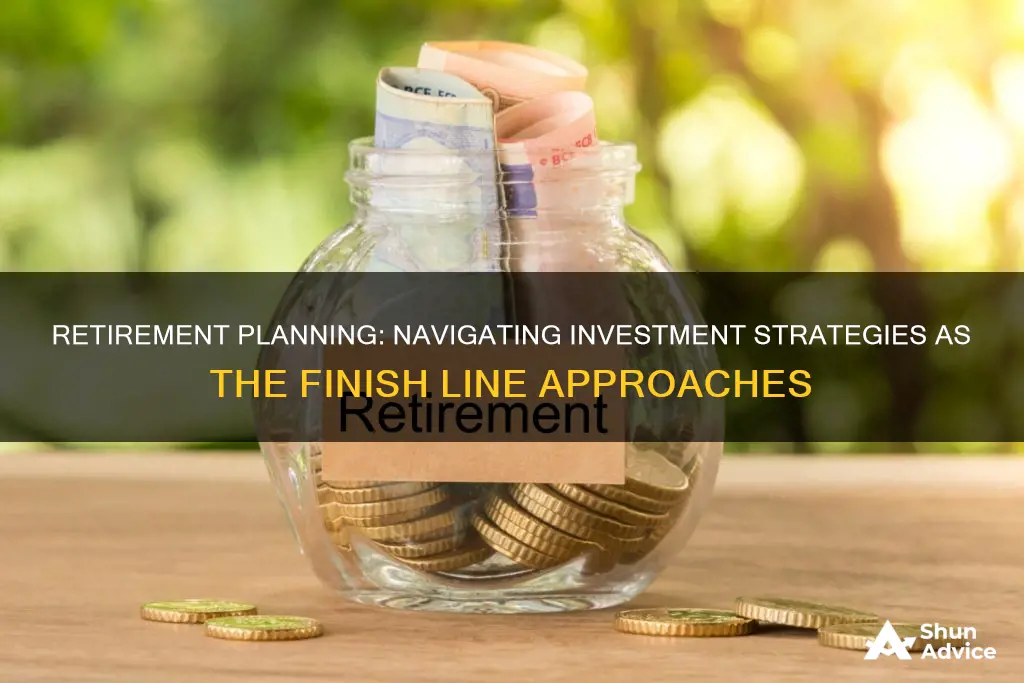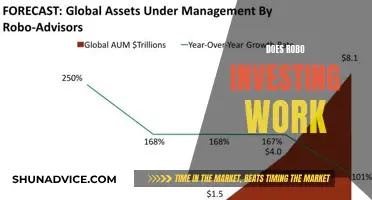
As you approach retirement, it is generally recommended to adjust your retirement investments to reduce risk and safeguard your savings. While younger investors can tolerate more risk, those nearing retirement have less time to recover from market downturns and losses. Therefore, transitioning to a more conservative portfolio with a mix of stocks and bonds can help strike a balance between protecting your savings and maintaining growth potential.
It is important to focus on your long-term retirement goals and not make impulsive decisions based on short-term market fluctuations. Consulting a financial professional can provide personalised advice and help you navigate market volatility. Additionally, utilising tools like target-date funds or robo-advisors can assist in adjusting your investment allocation as you approach retirement.
| Characteristics | Values |
|---|---|
| Should you adjust your retirement investments as you near retirement? | Yes, as your tolerance for risk decreases as you age. |
| How to adjust investments | Move from stocks to bonds and cash. |
| When to adjust investments | When there is a change in your investing goals' time horizons, and consequently, your risk tolerance. |
| How often to adjust investments | Gradually change and adjust your investments over time. |
What You'll Learn

Consider switching to a target date fund (TDF) or managed account
As you approach retirement, you may want to consider switching to a target date fund (TDF) or a managed account. These investment options can provide several benefits and help you achieve your retirement goals. Here's why considering a switch might be a good idea:
- Automatic Adjustment of Investment Strategy: Target date funds are designed with a specific retirement age in mind. As the target date approaches, the fund automatically adjusts its investment strategy to become more conservative. This means the fund will increase exposure to typically more conservative investments while reducing exposure to aggressive investments. This adjustment helps you focus on stability rather than high-risk, high-reward investments as you near retirement.
- Alignment with Retirement Goals: As you get closer to retirement, your investment goals shift from aggressive growth to stability and preservation of capital. A TDF or managed account can help align your investments with these changing goals. By automatically rebalancing your portfolio, these options ensure that your asset allocation matches your risk tolerance and time horizon.
- Simplicity and Convenience: With a TDF or a managed account, you don't need to worry about actively managing your investments. These options take care of the day-to-day investment decisions for you, providing a hands-off approach to investing. This can be especially beneficial if you don't have the time or expertise to actively manage your portfolio.
- Diversification: TDFs and managed accounts offer diversification across various asset classes, industries, company sizes, and investment styles. This diversification helps minimize risk and maximize potential returns by not putting all your eggs in one basket. It ensures that your portfolio is well-balanced and tailored to your retirement needs.
- Professional Management: Managed accounts provide access to professional money managers who make investment decisions on your behalf. These experts have the knowledge and experience to navigate market volatility and adjust your portfolio as needed. This can be particularly valuable during turbulent market conditions or when you seek personalized advice.
- Risk Mitigation: As you approach retirement, reducing investment risk becomes crucial. TDFs and managed accounts help mitigate risk by adjusting your asset allocation to match your retirement timeline. They ensure that you don't take on excessive risk as you near retirement, protecting your savings from potential market downturns.
When considering a switch to a TDF or a managed account, it's important to evaluate your specific circumstances, risk tolerance, and retirement goals. Consult with a financial professional to determine if this strategy aligns with your needs and to understand the potential benefits and drawbacks for your retirement plan.
Mortgage Dilemma: Pay Off or Invest?
You may want to see also

Focus on your retirement goals, not the news headlines
As you get closer to retirement, it's normal to worry about investment losses, but it's important to focus on your retirement goals and achievements, rather than getting caught up in the news headlines.
Stock markets fluctuate daily, and news stories tend to follow these ups and downs. This can cause you to lose sight of your long-term goals. It's important to remember that investing is a long-term game, and while you may see losses in the short term, you will also see gains.
Creating clear retirement goals with specific timelines can help you stay focused. For example, if you plan to retire early, you will need more robust returns to sustain your portfolio through what will likely be a longer-than-normal retirement. On the other hand, if you're retiring sooner than expected, you may need to reduce your risk exposure.
It's also a good idea to consult a financial professional to help you understand how market movements might impact your plans. They can provide personalised advice and help you make informed decisions about your investments.
While it's generally recommended to reduce your stock holdings as you get closer to retirement, it's important to remember that every individual's circumstances are unique. Your risk tolerance, time horizon, and financial goals will all play a role in determining the optimal asset allocation for your investment portfolio.
Smart Ways to Invest $500 Today
You may want to see also

Control what you can by reviewing and adjusting contributions
As you get closer to retirement, it's crucial to take control of your financial future by reviewing and adjusting your retirement contributions. Here are some detailed instructions to help you navigate this process:
Regularly Review Your Retirement Contributions:
Don't just set up your retirement contributions and forget about them. It's important to review them regularly to ensure you're on track to meet your financial goals. Life circumstances can change, and your investments should reflect those changes. Review your accounts, evaluate their performance, and make adjustments as necessary.
Understand Your Risk Tolerance:
As you approach retirement, you may want to reconsider your risk tolerance. Generally, younger investors can tolerate more risk and have time to recover from market downturns. However, as you get closer to retirement, a significant dip in the market could impact your plans. Therefore, you may want to gradually shift your assets from high-risk stocks to more stable investments.
Adjust Your Contribution Amount:
Depending on your financial situation, you may need to increase or decrease your contribution amount. If your income has increased and you're more financially stable, consider boosting your contributions. On the other hand, if you're experiencing financial difficulties, you may need to reduce your contributions temporarily. Remember to treat these contributions as a current expense and regularly review your budget to ensure you're contributing an amount that aligns with your goals.
Take Advantage of Employer Matching:
If your employer offers matching contributions, make sure you're contributing enough to take full advantage of this benefit. It's like getting free money added to your retirement savings. Understand the rules and guidelines for employer matching, including any vesting schedules, to maximize this opportunity.
Evaluate Your Investment Options:
Retirement plans like 401(k)s offer various investment options, such as mutual funds, stocks, and bonds. It's important to understand these options and choose ones that align with your risk tolerance and financial goals. Diversifying your investments can help spread risk and maximize returns.
Stay Informed and Seek Advice:
Stay informed about market trends and seek advice from financial advisors or by using online tools and resources. Understanding market conditions can help you make more strategic decisions about adjusting your contributions and investment choices. Additionally, a financial advisor can provide personalized advice and help you navigate the complexities of retirement planning.
By following these steps and staying proactive, you can take control of your retirement planning and increase your chances of achieving a secure financial future. Remember to review your contributions regularly and make adjustments as your life circumstances and financial goals evolve.
Smart Ways to Invest $1,000
You may want to see also

Match your investment risk with your age and risk tolerance
When it comes to retirement investments, it's important to consider your age and risk tolerance to ensure your portfolio aligns with your financial goals and comfort level. Here are some insights to help you match your investment risk with your age and risk tolerance:
Understanding Risk Tolerance:
Risk tolerance refers to the degree of risk an investor is willing to take on within their investment portfolio. It is influenced by factors such as age, investment goals, income, and investment experience. Younger investors are generally considered to have a higher risk tolerance due to their longer time horizon, which allows for potential recovery from market downturns. However, it's important to note that age is not the sole determinant, and individuals should carefully assess their financial situation and comfort with risk.
Age and Risk Tolerance:
As you approach retirement, it's common to adjust your investment portfolio to reduce risk and preserve your savings. Here are some guidelines based on your age:
- In your 20s and 30s: Many young investors are advised to take on more risk during these years due to their longer time horizon. All-stock portfolios are commonly recommended, but it's important to consider individual risk tolerance.
- In your 40s and 50s: As you enter middle age, you may want to balance your investments by including more stable, lower-risk options like bonds. This provides added stability while still allowing for growth.
- In your 60s: At this stage, a balanced portfolio with a mix of stocks and bonds is often suggested. A 60/40 or 50/50 split between stocks and bonds can provide growth potential while reducing risk exposure.
- In your 70s and beyond: Even during retirement, there is still a need for growth in your portfolio. However, stability becomes increasingly important. Advisors often recommend a balanced portfolio with a 50/50 split between stocks and bonds to provide both growth and stability.
Matching Risk Tolerance with Investment Choices:
Your risk tolerance will influence the types of investments you choose. Here are some common investment choices based on risk tolerance:
- Aggressive Risk Tolerance: Investors with a high-risk tolerance are willing to take on more risk for potentially higher returns. They often invest in stocks, equity funds, and exchange-traded funds (ETFs).
- Moderate Risk Tolerance: These investors seek a balance between growth and risk mitigation. Their portfolios typically include a mix of stocks and bonds, such as a 50/50 or 60/40 structure.
- Conservative Risk Tolerance: Conservative investors prioritize capital preservation and low volatility. They often invest in low-risk options such as bank certificates of deposit (CDs), money market funds, or U.S. Treasury securities.
Adjusting Your Portfolio Over Time:
It's important to remember that your investment portfolio doesn't have to remain static. As you approach retirement, you may want to gradually adjust your asset allocation to reduce risk. This process is known as creating a "glide path" toward a more conservative portfolio. Additionally, consider diversifying your investments across different asset classes, industries, company sizes, and geographic regions to further manage risk.
Your Investment Mix: Balancing Risk and Reward
You may want to see also

Consult a financial professional for personalised advice
Consulting a financial professional is a good idea when you're nearing retirement and want to adjust your investments. They can provide personalised advice that takes into account your unique circumstances, goals, and risk tolerance. Here are some reasons why seeking professional advice can be beneficial:
- Expertise and Experience: Financial professionals have the knowledge and experience to guide you through the complexities of retirement planning. They can provide insights into market trends, investment strategies, and potential risks and opportunities.
- Personalised Strategies: A financial advisor will tailor their recommendations to your specific situation. They will consider factors such as your age, retirement timeline, financial goals, and risk tolerance to create a plan that aligns with your needs.
- Risk Management: As you approach retirement, managing risk becomes increasingly important. A financial professional can help you assess your current investment mix and make adjustments to match your risk tolerance and retirement goals. They can advise on diversifying your portfolio or transitioning to more stable, lower-risk investments.
- Tax Implications: Retirement planning often involves understanding tax strategies and regulations. Financial professionals can help you navigate tax implications, such as contribution limits, tax-deferred accounts, and strategies to minimise taxes when selling investments or withdrawing funds.
- Peace of Mind: Consulting an expert can give you confidence and peace of mind. They can provide clarity during volatile market conditions and help you avoid making impulsive decisions based on short-term market fluctuations. They can also help you set clear retirement goals and create a plan to achieve them.
- Ongoing Support: Financial advisors can provide ongoing support and guidance as you transition into retirement and throughout your retirement years. They can help you regularly review and adjust your investment strategies to ensure they remain aligned with your goals and changing market conditions.
Remember, while online resources and robo-advisors can provide general guidance, they may not offer the same level of personalisation and tailored advice as a financial professional who understands your unique circumstances. Seeking professional advice can help you make more informed decisions about your retirement investments and ensure that your financial plans are on track.
The Great Debate: Mortgage vs. Investment — Where Should Your Money Go?
You may want to see also
Frequently asked questions
Generally, as you get older, you should scale back on the percentage of stocks in your portfolio and increase the percentage of bonds in your portfolio. Stocks are volatile and can lose you a lot of money in the short term, while bonds are more stable and less volatile.
You can use a tool like an asset allocation-risk tolerance questionnaire to determine the right mix of stocks and bonds for you. Alternatively, you can consult a financial professional for personalized advice.
Apart from nearing retirement, you may also want to adjust your retirement investments if there has been a change in your investing goals' time horizons, and consequently, your risk tolerance. For example, if you're retiring sooner than expected, you may need to put your money in lower-risk investments.
Here are some tips to protect your retirement savings from market volatility:
- Focus on your retirement goals and achievements, rather than the news headlines.
- Control what you can by reviewing and adjusting your contributions. For example, you could boost salary deferral or individual retirement account contributions.
- Match your investment risk with your age and risk tolerance. As you get closer to retirement, a less risky investment mix may be more suitable.
- Consult a financial professional for personalized advice and to better understand how market moves could affect your plans.







